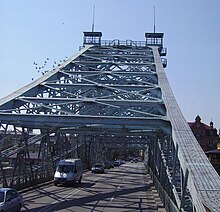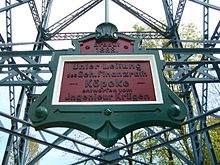Claus Koepcke
Claus Koepcke (also Köpcke , born October 28, 1831 in Borstel , † November 21, 1911 in Dresden ) was a German civil engineer and scientist .
Life


Claus Koepcke was born on October 28, 1831 in Borstel, today part of Jork ( Altes Land ), as the son of an Elbe ship. From 1848 to 1853 he studied at the Polytechnic School in Hanover , where he passed the state examination for engineering and architecture.
The first activities were port and storage buildings in Harburg . From 1863 he worked for the Hanover State Railroad, first as a laborer, then two years later as construction director. His steep and rapid career led him to the Prussian Ministry of Commerce in 1868, where he was employed as a councilor in the "Technical Bureau". Only one year later he was appointed professor for railway, hydraulic and bridge construction at the Polytechnic in Dresden . There he was the successor to Johann Andreas Schubert , the builder of the first German steam locomotive and the Elstertal and Göltzschtal bridges . Likewise, as Schubert's successor, he was given the position of technical advisor to the Ministry of Finance.
From 1872 Koepcke was responsible for the expansion of the railway system in the Saxon Ministry of Finance. As a secret finance councilor and lecturer council, he had major responsibility for the development of the Saxon narrow-gauge railways . Several important bridges were built under his leadership: the Elbe Bridge in Riesa in 1878, the Markersbach Viaduct from 1888 to 1889, the Blue Wonder between the Dresden suburbs of Loschwitz and Blasewitz in 1893 and the railway bridge next to the Marienbrücke in Dresden from 1898 to 1900. Also involved in the redesign of the Dresden main station with the hall construction he was involved from 1892 to 1898. On June 24, 1893 Koepcke received the kk and ku privilege on a sand track to stop railway vehicles , on February 5, 1895 an kk privilege on improved rail joint connections .
Koepcke dealt with the problems with suspension bridges (control of the vibration behavior through stiffening and the use of spring joints and vibration dampers, the "bridge brakes") and thought about vibrations in bell chairs. "This rich amount of work could only be done by a man who, in addition to the urge for scientific knowledge, possessed that iron strength of will that was Köpcke's most prominent trait: there were no obstacles and difficulties for him," says an obituary for Koepcke.
Koepcke's work was honored during his lifetime:
- In 1893 he was appointed to the Privy Council
- 1901 Honorary Doctoral Engineer from the Technical University of Hanover.
- In 1903 he resigned from civil service - as a ministerial conductor. Shortly before his death, the state of Saxony awarded him the titles “Real Privy Councilor” and “Excellence” for his services.
Claus Koepcke died in Dresden on November 21, 1911. He is buried in the Tolkewitz urn grove .
Commemoration
The Association for the Promotion of Saxon Narrow Gauge Railways has been awarding the Claus Köpcke Prize since 2003, commemorating this civil engineer. Associations and organizations that have made a contribution to the maintenance and further development of the Saxon narrow-gauge railways and their history are honored.
Köpckestrasse in the Innere Neustadt district of Dresden is named after Claus Koepcke.
literature
- Claudia Elbert: Claus Köpcke 1831-1911: Networks; Biography of an engineer . KIT Scientific Publishing, Karlsruhe 2011, ISBN 978-3866447585
- Dietrich Conrad: Claus Köpcke - civil engineer and scientist . Sandstein Verlag, Dresden 2010, ISBN 978-3-942422-04-8 .
- Christoph Pötzsch : fates in Dresden's Tolkewitz cemetery . Tauchaer Verlag, Taucha 2005.
Web links
- Literature by and about Claus Koepcke in the catalog of the German National Library
- Information about Claus Köpcke on the VSSB website
Individual evidence
- ^ Invention privileges . (...) 83. To Claus Köpcke in Dresden (...). In: Official Journal of the Wiener Zeitung , No. 193/1893, August 24, 1893, p. 260, column 1. (Online at ANNO ). .
- ↑ Invention privileges. (...) 94. To Claus Köpcke in Dresden (...). In: Official Journal of the Wiener Zeitung , No. 70/1895, March 22, 1895, p. 418, column 2. (Online at ANNO ). .
| personal data | |
|---|---|
| SURNAME | Koepcke, Claus |
| ALTERNATIVE NAMES | Köpcke, Claus |
| BRIEF DESCRIPTION | German engineer and professor |
| DATE OF BIRTH | October 28, 1831 |
| PLACE OF BIRTH | Borstel |
| DATE OF DEATH | November 21, 1911 |
| Place of death | Dresden |
